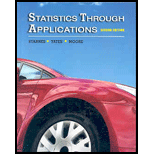
Concept explainers
(a)
To show that this is a binomial setting.
(a)
Explanation of Solution
Given:
We know that the Binomial theorem is as:
The four conditions for a binomial setting are: binary (success/failure), independent trials, fixed number of trials and the probability of success is the same for each trial.
Binary: Satisfied because success is “Win game” and failure is “Lose game”.
Independent trials: Satisfied, assuming that the different games are independent.
Fixed number of trials: Satisfied, because the fixed number of trials are
Probability of Success: Satisfied, because the probability of success is
Thus the setting is binomial.
(b)
To calculate and interpret
(b)
Answer to Problem 8.76RE
The probability is
Explanation of Solution
Given:
We know that the Binomial theorem is as:
Evaluate at
(c)
To calculate and interpret
(c)
Answer to Problem 8.76RE
Explanation of Solution
Given:
We know that the Binomial theorem is as:
Evaluate at
Use the addition rule:
Use the compliment rule:
(d)
To explain how much money should the player expect to win or lose in
(d)
Answer to Problem 8.76RE
Lose
Explanation of Solution
In the previous exercise, we found that you were expected to lose
Thus, you are then expected to lose:
You have to lose
Chapter 8 Solutions
Statistics Through Applications
Additional Math Textbook Solutions
Basic Business Statistics, Student Value Edition
Elementary Statistics: Picturing the World (6th Edition)
Intro Stats, Books a la Carte Edition (5th Edition)
Statistics: The Art and Science of Learning from Data (4th Edition)
Introductory Statistics
Elementary Statistics (13th Edition)
 MATLAB: An Introduction with ApplicationsStatisticsISBN:9781119256830Author:Amos GilatPublisher:John Wiley & Sons Inc
MATLAB: An Introduction with ApplicationsStatisticsISBN:9781119256830Author:Amos GilatPublisher:John Wiley & Sons Inc Probability and Statistics for Engineering and th...StatisticsISBN:9781305251809Author:Jay L. DevorePublisher:Cengage Learning
Probability and Statistics for Engineering and th...StatisticsISBN:9781305251809Author:Jay L. DevorePublisher:Cengage Learning Statistics for The Behavioral Sciences (MindTap C...StatisticsISBN:9781305504912Author:Frederick J Gravetter, Larry B. WallnauPublisher:Cengage Learning
Statistics for The Behavioral Sciences (MindTap C...StatisticsISBN:9781305504912Author:Frederick J Gravetter, Larry B. WallnauPublisher:Cengage Learning Elementary Statistics: Picturing the World (7th E...StatisticsISBN:9780134683416Author:Ron Larson, Betsy FarberPublisher:PEARSON
Elementary Statistics: Picturing the World (7th E...StatisticsISBN:9780134683416Author:Ron Larson, Betsy FarberPublisher:PEARSON The Basic Practice of StatisticsStatisticsISBN:9781319042578Author:David S. Moore, William I. Notz, Michael A. FlignerPublisher:W. H. Freeman
The Basic Practice of StatisticsStatisticsISBN:9781319042578Author:David S. Moore, William I. Notz, Michael A. FlignerPublisher:W. H. Freeman Introduction to the Practice of StatisticsStatisticsISBN:9781319013387Author:David S. Moore, George P. McCabe, Bruce A. CraigPublisher:W. H. Freeman
Introduction to the Practice of StatisticsStatisticsISBN:9781319013387Author:David S. Moore, George P. McCabe, Bruce A. CraigPublisher:W. H. Freeman





